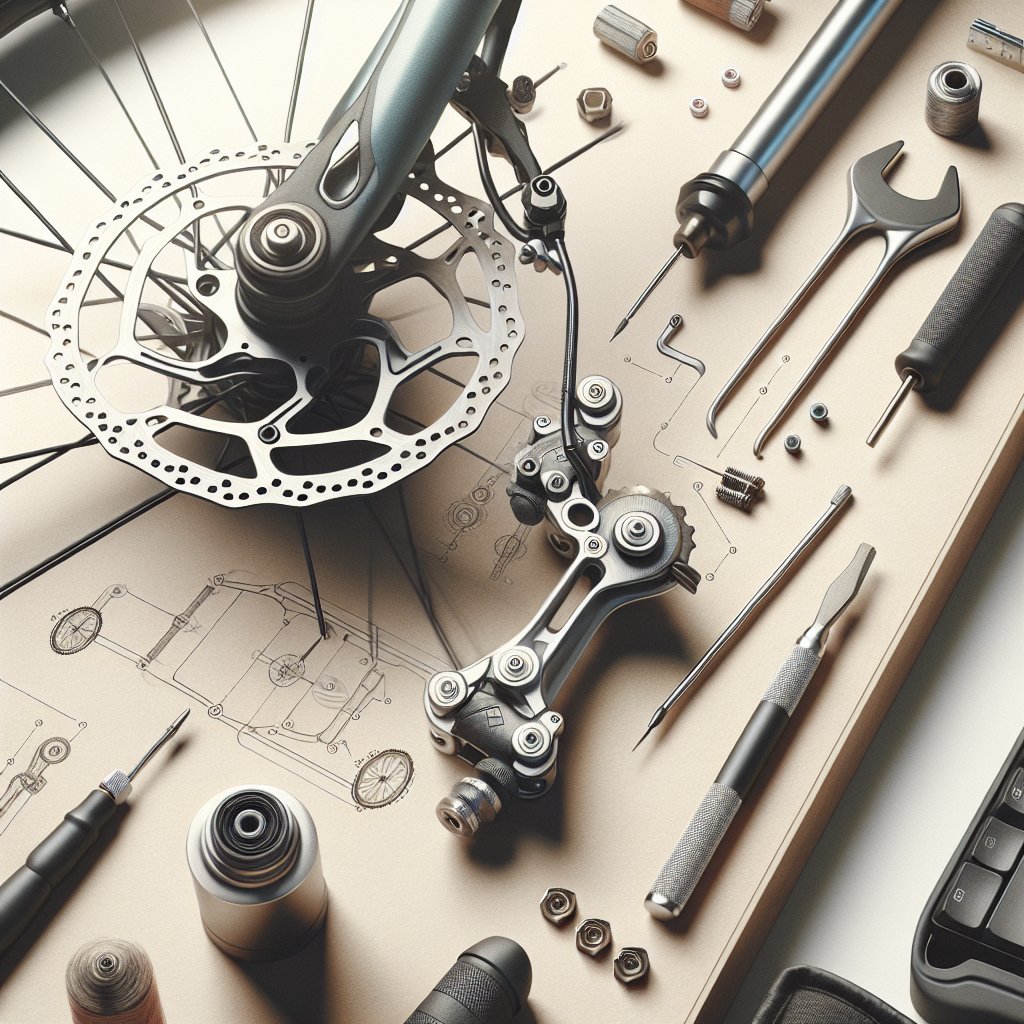Properly adjusted bicycle brakes are crucial for ensuring safety and optimal performance while riding. Whether you’re a casual cyclist or a seasoned rider, understanding how to fine-tune your brakes can make a significant difference in your biking experience. This article will guide you through the steps to adjust your bicycle brakes for optimal performance, covering both rim brakes and disc brakes.
Understanding Different Types of Bicycle Brakes
Before diving into the adjustment process, it’s essential to understand the different types of bicycle brakes. The two most common types are rim brakes and disc brakes. Each type has its own set of components and requires a slightly different approach to adjustment.
Rim Brakes
Rim brakes are the traditional type of brakes found on many bicycles. They work by applying friction to the wheel’s rim to slow down or stop the bike. There are several variations of rim brakes, including caliper brakes, cantilever brakes, and V-brakes. Each type has its own unique mechanism, but the basic principles of adjustment are similar.
Disc Brakes
Disc brakes are becoming increasingly popular, especially on mountain bikes and high-performance road bikes. They use a rotor attached to the wheel hub and a caliper that squeezes the rotor to create friction. Disc brakes can be either mechanical (cable-actuated) or hydraulic. While they offer superior stopping power and performance in wet conditions, they also require more precise adjustments.
Tools You’ll Need
To adjust your bicycle brakes, you’ll need a few basic tools. Having the right tools on hand will make the process smoother and more efficient. Here is a list of essential tools:
- Allen wrenches (typically 4mm, 5mm, and 6mm)
- Screwdrivers (Phillips and flathead)
- Needle-nose pliers
- Brake pad alignment tool (optional but helpful)
- Lubricant (for cables and pivot points)
- Rag or paper towels (for cleaning)
Adjusting Rim Brakes
Adjusting rim brakes involves several steps, including aligning the brake pads, adjusting the cable tension, and centering the brake calipers. Follow these steps to ensure your rim brakes are properly adjusted:
Step 1: Inspect the Brake Pads
Start by inspecting the brake pads for wear. If the pads are worn down to the wear indicators or show uneven wear, it’s time to replace them. New brake pads will provide better stopping power and reduce the risk of damaging the rim.
Step 2: Align the Brake Pads
Proper alignment of the brake pads is crucial for effective braking. The pads should make full contact with the rim without touching the tire. To align the pads:
- Loosen the bolt holding the brake pad in place using an Allen wrench.
- Position the pad so that it is parallel to the rim and centered on the braking surface.
- Tighten the bolt while holding the pad in place.
- Repeat the process for the other brake pad.
Step 3: Adjust the Cable Tension
Proper cable tension ensures that the brake lever has the right amount of travel and that the brakes engage effectively. To adjust the cable tension:
- Loosen the cable anchor bolt using an Allen wrench.
- Pull the cable through the anchor bolt to increase tension or release some cable to decrease tension.
- Tighten the anchor bolt while holding the cable in place.
- Test the brake lever to ensure it has the desired amount of travel and that the brakes engage smoothly.
Step 4: Center the Brake Calipers
Centering the brake calipers ensures that both brake pads make contact with the rim simultaneously. To center the calipers:
- Loosen the mounting bolt that attaches the caliper to the frame or fork.
- Adjust the caliper so that it is centered over the rim.
- Tighten the mounting bolt while holding the caliper in place.
- Spin the wheel and check for any rubbing or uneven contact. Make further adjustments if necessary.
Adjusting Disc Brakes
Adjusting disc brakes involves aligning the caliper, adjusting the brake pads, and setting the correct cable tension (for mechanical disc brakes) or bleeding the brake system (for hydraulic disc brakes). Follow these steps to ensure your disc brakes are properly adjusted:
Step 1: Align the Caliper
Proper caliper alignment ensures that the brake pads make even contact with the rotor. To align the caliper:
- Loosen the caliper mounting bolts using an Allen wrench.
- Squeeze the brake lever to center the caliper over the rotor.
- While holding the brake lever, tighten the mounting bolts.
- Release the brake lever and spin the wheel to check for any rubbing or uneven contact. Make further adjustments if necessary.
Step 2: Adjust the Brake Pads
For mechanical disc brakes, you may need to adjust the position of the brake pads to ensure they make proper contact with the rotor. To adjust the brake pads:
- Locate the pad adjustment screws on the caliper.
- Turn the screws to move the pads closer to or further from the rotor.
- Ensure that the pads are evenly spaced and make full contact with the rotor when the brake lever is engaged.
Step 3: Set the Cable Tension (Mechanical Disc Brakes)
Proper cable tension is crucial for mechanical disc brakes. To adjust the cable tension:
- Loosen the cable anchor bolt using an Allen wrench.
- Pull the cable through the anchor bolt to increase tension or release some cable to decrease tension.
- Tighten the anchor bolt while holding the cable in place.
- Test the brake lever to ensure it has the desired amount of travel and that the brakes engage smoothly.
Step 4: Bleed the Brake System (Hydraulic Disc Brakes)
Hydraulic disc brakes require periodic bleeding to remove air bubbles from the brake lines and ensure consistent braking performance. Bleeding the brake system can be a complex process, so it’s recommended to follow the manufacturer’s instructions or seek professional assistance. The general steps for bleeding hydraulic brakes are:
- Attach the bleed kit to the brake caliper and lever.
- Open the bleed valves and pump the brake lever to expel air bubbles.
- Close the bleed valves and remove the bleed kit.
- Test the brake lever to ensure it feels firm and responsive.
Maintenance Tips for Optimal Brake Performance
Regular maintenance is essential for keeping your bicycle brakes in top condition. Here are some tips to help you maintain optimal brake performance:
Clean the Brake Pads and Rims/Rotor
Dirt and debris can accumulate on the brake pads and rims or rotors, reducing braking efficiency. Regularly clean the brake pads and rims or rotors with a rag and a suitable cleaning solution. Avoid using oil-based cleaners, as they can leave a residue that reduces friction.
Inspect and Replace Worn Components
Regularly inspect the brake pads, cables, and other components for wear and damage. Replace worn or damaged parts promptly to ensure consistent braking performance. Brake pads should be replaced when they are worn down to the wear indicators or show uneven wear.
Lubricate Moving Parts
Lubricate the pivot points and cables to ensure smooth operation. Use a suitable lubricant and avoid over-lubricating, as excess lubricant can attract dirt and debris.
Check Brake Alignment
Periodically check the alignment of the brake pads and calipers to ensure they are properly positioned. Misaligned brakes can cause uneven wear and reduce braking efficiency.
Conclusion
Adjusting your bicycle brakes for optimal performance is a crucial skill for any cyclist. Whether you have rim brakes or disc brakes, following the steps outlined in this article will help you achieve smooth and effective braking. Regular maintenance and inspection will ensure that your brakes remain in top condition, providing you with a safe and enjoyable riding experience. Remember, well-maintained brakes are essential for your safety, so take the time to adjust and maintain them properly.



